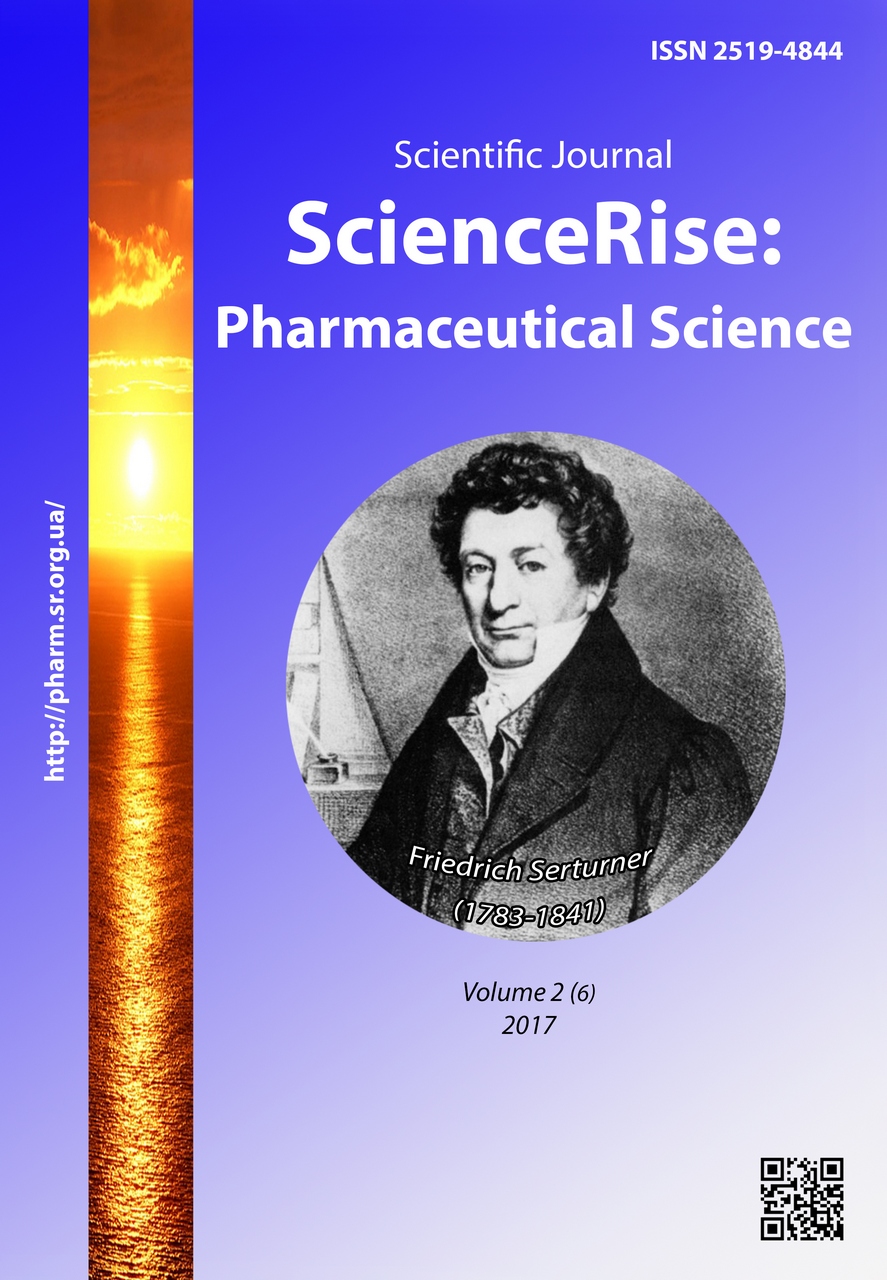Determination of agomelatine in urine in the presence of metabolites by gas chromatography-mass spectrometry (GC-MS)
DOI:
https://doi.org/10.15587/2519-4852.2017.97922Keywords:
agomelatine, urine, antidepressant, identification, quantitative determination, extraction, metabolite, GC/MS, reference solution, validationAbstract
Aim. Development and validation of the method for quantitative determination of agomelatine in urine in the presence of its metabolites using GC-MS.
Methods. Chloroform was used to extract agomelatine from the urine samples, after sedimentation of uric acids by Calcium chloride. Identification and assay of the extracted agomelatine was carried out using Agilent 6890 N chromatograph with 5978 BMSD (Agilent technologies, USA) mass spectroscopy detector. Restek Rtx-5 (USA) column with 5% phenyl methyl siloxane (30m×0.25mm;0.25μm) was used for separation of the components. Carrier gas was helium. Mass detection was performed during 70 eV electronic ionization and 400 V voltages. Scanning was carried out in Scan mode within 50-550 u.
Results. The developed method for agomelatine determination was validated in agomelatine linear concentration range 40-6000 ng/ml with the correlation coefficient 0.99975. The method is correct and reproducible by all parameters in the linear range of concentrations according to OECD/WHO GLP requirements, and FDA, EMA and Ministry of Health of Ukraine recommendations.
Conclusion. 15 ng of agomelatine can be identified in 1 ml of urine, and 40 ng of it can be quantified by the displayed method. The total content of the detected metabolites on agomelatine concentration was approximately 35.0%. The developed method is characterized by implementation simplicity, accuracy and reproducibility, and it can be used for chemical and toxicological analysis of agomelatineReferences
- Levitan, M., Papelbaum, M., E Nardi, A. (2015). Profile of agomelatine and its potential in the treatment of generalized anxiety disorder. Neuropsychiatric Disease and Treatment, 11, 1149–1155. doi: 10.2147/ndt.s67470
- Woo, Y. S., Wang, H. R., Bahk, W. M. (2014). Agomelatine: The Novel Antidepressant. Korean Journal of Psychopharmacology, 25 (1), 1–10.
- Llorca, P.-M. (2010). The antidepressant agomelatine improves the quality of life of depressed patients: implications for remission. Journal of Psychopharmacology, 24 (2), 21–26. doi: 10.1177/1359786810372978
- Loo, H., Hale, A., Dhaenen, H. (2002). Determination of the dose of agomelatine, a melatoninergic agonist and selective 5-HT2C antagonist, in the treatment of major depressive disorder: a placebo-controlled dose range study. International Clinical Psychopharmacology, 17 (5), 239–247. doi: 10.1097/00004850-200209000-00004
- Wang, X.-L., Du, A.-H., Zhang, D., Meng, L.-J., Liu, M., Zhang, L.-N. et. al. (2014). Inter- and Intra-individual Variability in the Pharmacokinetics of Agomelatine Tablets in Chinese Healthy Male Subjects. Drug Research, 65 (10), 552–554. doi: 10.1055/s-0034-1394436
- Pei, Q., Wang, Y., Hu, Z.-Y., Liu, S.-K., Tan, H.-Y., Guo, C.-X. et. al. (2014). Evaluation of the Highly Variable Agomelatine Pharmacokinetics in Chinese Healthy Subjects to Support Bioequivalence Study. PLoS ONE, 9 (10), e109300. doi: 10.1371/journal.pone.0109300
- Australian Public Assessment Report for Agomelatine (2010). 3–72. Available at: https://www.tga.gov.au/sites/default/files/auspar-valdoxan.pdf
- Fornaro, M., Prestia, D., Colicchio, S., Perugi, G. (2010). A Systematic, Updated Review on the Antidepressant Agomelatine Focusing on its Melatonergic Modulation. Current Neuropharmacology, 8 (3), 287–304. doi: 10.2174/157015910792246227
- Cardinali, D. P., Vidal, M. F., Vigo, D. E. (2012). Agomelatine: Its Role in the Management of Major Depressive Disorder. Clinical Medicine Insights: Psychiatry, 4, 1–23. doi: 10.4137/cmpsy.s7989
- Freiesleben, S. D., Furczyk, K. (2015). A systematic review of agomelatine-induced liver injury. Journal of Molecular Psychiatry, 3 (1), 4. doi: 10.1186/s40303-015-0011-7
- Stuhec, M. (2013). Agomelatine-induced hepatotoxicity. Wiener Klinische Wochenschrift, 125 (7-8), 225–226. doi: 10.1007/s00508-013-0344-0
- Montastruc, F., Scotto, S., Vaz, I. R., Guerra, L. N., Escudero, A., Sainz, M. et. al. (2014). Hepatotoxicity Related to Agomelatine and Other New Antidepressants. Journal of Clinical Psychopharmacology, 34 (3), 327–330. doi: 10.1097/jcp.0000000000000094
- Imboden, C., Hatzinger, M. (2012). Agomelatine-Induced Akathisia with Concomitant Duloxetine Medication: A Case Report. Pharmacopsychiatry, 45 (4), 162–163. doi: 10.1055/s-0031-1297933
- Janga, K. Y., Pasupunoot, S. (2013). Quantification of Agomelatine in Rat Plasma by Validated Bioanalytical Rapid RP-HPLC/UV Method. Kakatiya Institute of Pharmaceutical Sciences, 45, 215–221.
- Patil, S. R., Nerurkar, K. K., Kalamkar, A. M., Pukale, V., Mangaonkar, K. V., Pingale, S. G. (2012). Validated LC-MS/MS method for quantification of agomelatine in human plasma and its application in a pharmacokinetic study. Journal of Mass Spectrometry, 47 (1), 23–28. doi: 10.1002/jms.2020
- Rallis, G. N., Petrikis, P., Boumba, V. A. (2016). Development and Validation of an UHPLC-UV method for the Determination of Agomelatine in Human Plasma and Serum Suitable for Routine Clinical Analysis. Annals of Chromatography and Separation Techniques, 2 (2), 1020–1026.
- Li, M., Tang, F., Xie, F., Lv, Y., Yu, P., Liu, Z., Cheng, Z. (2015). Development and validation a LC–MS/MS method for the simultaneous determination of agomelatine and its metabolites, 7-desmethyl-agomelatine and 3-hydroxy-agomelatine in human plasma: Application to a bioequivalence study. Journal of Chromatography B, 1003, 60–66. doi: 10.1016/j.jchromb.2015.09.018
- Meghana, M., Sridhar, T., Venisetty, R. K. K. (2014). Development and Validation of Stability- Indicating RP-HPLC Method for the Estimation of Agomelatine in API. Research Journal of Pharmaceutical, Biological and Chemical Sciences, 5 (1), 621–628.
- Improving Treatment for Drug-Exposed Infants. Appendix C. Urine toxicology Guidelines (1993). 93.
- Telles-Correia, D., Barbosa, A., Cortez-Pinto, H., Campos, C., Rocha, N. B., Machado, S. (2017). Psychotropic drugs and liver disease: A critical review of pharmacokinetics and liver toxicity. World journal of Gastrointestinal pharmacology and therapeutics, 8 (1), 26–38.
- Guideline on bioanalytical method validation (2011). European Medicines Agency, 23.
- Guidance for Industry. Bioanalytical Methods validation. Food and Drug administration (2001). Center for Drug Evaluation and Research, 25.
- Good Laboratory Practice. OECD principles and guidance for compliance monitoring (2005). OECD, 139.
- Zhukova, N. A., Libina, V. V., Kudris, I. V., Padalko, N. N. (2013). Bioanalytical Method Validation. Kyiv, 35.
- On approval of documents on quality assurance of medicines (2009). The Ministry of Health of Ukraine, No. 95. Available at: http://www.apteka.ua/article/242235
Downloads
Published
How to Cite
Issue
Section
License
Copyright (c) 2017 Natalia Darmograi, Iryna Galkevych

This work is licensed under a Creative Commons Attribution 4.0 International License.
Our journal abides by the Creative Commons CC BY copyright rights and permissions for open access journals.








